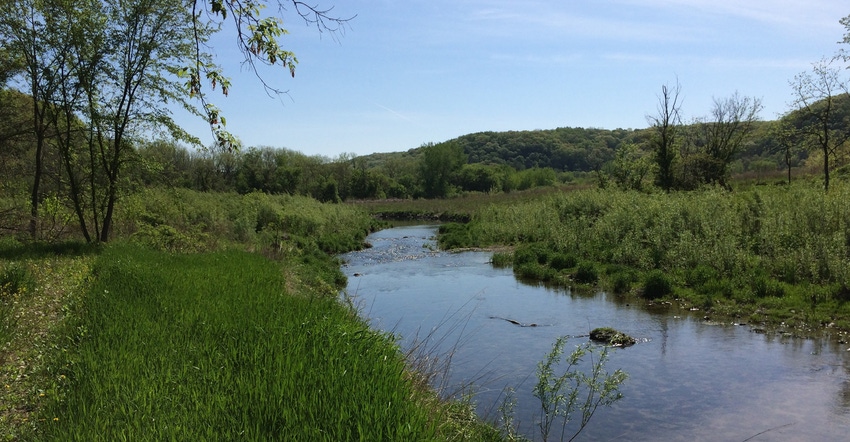July 7, 2020

The Iowa Nutrient Reduction Strategy annual report released July 1 reveals increases in farmer, landowner and community engagement, in conservation practices, and in funding for soil health and water quality projects.
Released by Iowa State University, the Iowa Department of Agriculture and Land Stewardship, and the Iowa Department of Natural Resources, the report dated June 2020 covers progress made during the 2018-19 reporting period.
The INRS goal is to direct efforts to reduce nutrients in surface water in a scientific, reasonable and cost-effective manner. Iowa adopted its nutrient reduction strategy in 2013 to reduce nitrogen and phosphorus loading in Iowa’s waterways.
The strategy calls for mandatory, regulated pollution discharge limits on point sources, such as wastewater treatment plants, factories and public water systems. For nonpoint sources of nutrient pollution — primarily agricultural operations — the plan outlines an entirely voluntary suite of practices that can be implemented to reduce nutrient pollution.
Conservation practices up
The INRS was introduced to reduce nutrient loads that flow to the Gulf of Mexico. The plan established a goal of a 45% reduction of annual nitrogen and phosphorus loads. Both point sources, such as wastewater treatment and industrial facilities, and nonpoint sources, such as agricultural fields, are highlighted by the INRS as areas in which nutrient reduction needs to occur.
The latest data, released in the June report, shows that the growing number of installed conservation practices reduced phosphorus losses by an estimated 18.5% during the 2006-10 period, compared to the 1980-96 baseline of the INRS.
The state has continuously made progress on reducing phosphorous losses from farm fields because of the increased adoption of soil conservation practices, including no-till and conservation tillage, cover crops and terraces, over the last two decades. During the same time frame, modeled nitrogen loads increased by an estimated 5%, characterizing the ongoing challenges related to nutrient reduction.
More nitrate reduction needed
“Efforts to improve water quality and soil health are happening all over Iowa. We have more partners and landowners engaged in conservation projects now than ever before,” says Iowa Secretary of Agriculture Mike Naig. “These efforts are resulting in progress being made, especially towards the state’s phosphorus reduction goals. We acknowledge more nitrogen-reducing conservation practices are needed to reach the nitrate reduction goals in our state’s waters.
“By tracking comprehensively, it helps us better allocate resources such as funding, and develop new approaches to guide the implementation of nutrient-reducing practices in priority watersheds around the state.”
It’s not just farmers who are making adjustments in their management of fertilizer and use of soil management practices to help improve water quality. Everyone has a role to play in helping improve Iowa’s water quality.
“Cities and industries across the state are committing to achieve significant nutrient reductions at their wastewater plants in the coming years and several are already doing so,” says Kayla Lyon, director of the Iowa Department of Natural Resources. “These improvements don’t happen overnight, and it’s gratifying to see the persistence of Iowans to keep moving forward in difficult times.”
Highlights of report
INRS highlights in 2018-19 include:
More money invested. An estimated $560 million was invested in education and outreach, research, practice implementation and water monitoring during the 2018-19 reporting period. This is an increase from $512 million during the 2017-18 reporting period.
Community engagement increases. A total of 540 outreach events were conducted in 98 counties by partner organizations (public, private and nongovernment organizations), with a total attendance of 50,800 people. Total events increased from 511 in 2018, and total attendance increased from 46,000.
Cover crop acres up. Iowa is planting at least 973,000 acres of cover crops according to the 2017 USDA Census of Agriculture, which reduces annual nitrogen losses by 4,300 tons and annual phosphorus losses by 330 tons. Estimated cover crop usage is even higher according to survey data collected by the Iowa Nutrient Research and Education Council.
Bioreactors and buffers help. There are at least 27 bioreactors and 13 saturated buffers in Iowa, which reduced nitrogen losses by 12 tons in 2018.
Wetlands added. The state has constructed 86 nitrate-removal wetlands. An additional 30 wetlands are under development and are expected to be completed within the next 24 months.
No-till up. No-till acreage increased from 6.9 million acres in 2012 to 8.2 million in 2017, according to the USDA Census of Agriculture.
Targets met. The INRS establishes a target of reducing total nitrogen and total phosphorus from point sources by 66% and 75%, respectively. In 2018, 20 municipalities and 22 industries met one or both of these targets. Additional highlights can be found in the INRS Executive Summary.
Emerging research
The Iowa Nutrient Research Center pursues science-based approaches to evaluating the performance of current and emerging conservation practices. INRC also investigates innovative methods to implement and develop new practices. This information is reviewed by the Nutrient Reduction Strategy Science Team, a group of university and public agency researchers, who develop recommendations for including new practices in the Nutrient Reduction Strategy. As technology and practices advance, new data is submitted for consideration in the NRS report.
Multipurpose oxbows are an example of the emerging conservation practices added as a documented practice in the NRS, based on research showing that targeted restoration of oxbows can reduce nitrate levels by 35% to 54%. This practice also creates habitat for waterfowl and other wildlife.
All Iowans are encouraged to take an active role in the state’s conservation efforts, Naig says. There are state and federal funding sources available to help farmers, landowners and communities offset the costs of urban and rural water quality improvement projects. Iowans can learn more about grants, cost-share programs, and how to get involved by contacting their local Soil and Water Conservation District office.
To read the 2018-19 Iowa Nutrient Reduction Strategy annual report in its entirety, visit nutrientstrategy.iastate.edu.
About the Author(s)
You May Also Like






